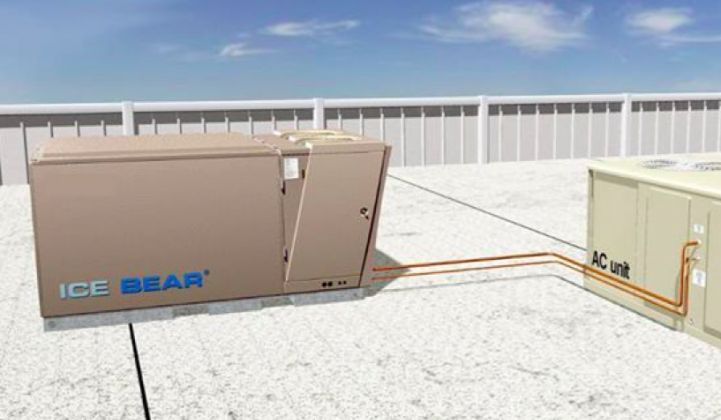For the past few years, Ice Energy has been working on combining its thermal energy-storing rooftop air conditioners with rooftop solar systems. The goal has been to determine if the Ice Bear storage units can stand in as a cheaper, more ubiquitous alternative to battery-backed solar for a wide range of tasks, such as demand-charge management, load shifting, peak demand reduction, and providing extra capacity for the grid.
On Wednesday, the company launched “Solar + Ice,” its first foray into commercializing this concept. The system offers utilities long-term power-purchase agreements (PPAs) for combined solar-storage systems, with a focus on the country’s energy storage hotspot, California. NRG is one of the first deployment partners.
Ice Energy has already deployed about 1,000 of its units for utility clients across California, each capable of “storing” about 10 kilowatts of energy per day. Its units defer energy consumption by chilling water with cheap nighttime or off-peak electricity, and then using the ice to run AC units during the heat of day without turning on their compressors.
This deferred energy usage can help level out the demand profile of a solar-equipped building, depending on how well it matches up with rooftop PV output. In general, air conditioning usage peaks later in the day than solar does, which means that a thermal storage system may have to fine-tune its operations to better smooth the interplay of the two.
Thermal energy storage has been a part of district energy systems for decades, but scaling it down to rooftop size is a newer development. The rooftop AC model matches well with rooftop PV, of course, since both systems can be installed at the same time.
Under its typical contracts, Ice Energy enables utility customers to offer low-cost or incentivized Ice Bears to big customers, with both sides sharing the benefits. The utility sees a reduction in troublesome peak energy usage, and the customer gets lower utility bills.
It will be interesting to see how NRG Energy plays a role in Ice Energy’s new offering. NRG has already teamed up with the startup on its 26.5-megawatt project with Southern California Edison. Under the terms of that project, Ice Energy will deploy about 1,800 Ice Bear units, starting in mid-2016, and will be responsible for manufacturing the units, managing site acquisition, installation and providing maintenance to the units. NRG will cover 100 percent of the capital costs, and will also get involved in site acquisition and marketing the program.
Solar + Ice is certainly coming into a crowded solar-storage field in California. Battery-backed solar is becoming a preferred way for commercial and industrial customers to do rooftop PV in the state. SunPower and Stem, SunEdison and Green Charge Networks, and of course, Tesla with partners including SolarCity, EnerNOC and Advanced Microgrid Solutions, are among the many firms entering the market, both for commercial and industrial customers or through utility contracts.
Energy storage can help reduce demand charges to match PV production, shift and smooth solar’s effect on the grid, and even provide a hedge against changes to utility tariffs or the state’s net-metering regime.
Thermal energy storage isn’t as flexible as battery-based storage, since it can only reduce air-conditioning load, not actually store grid or PV-generated electrons for later use. It also can’t inject power into the building or respond quickly to fluctuations in solar output.
Ice Energy has been working on the solar-thermal storage challenge since 2013, when it installed 35 kilowatts of Ice Bears on a Kohl’s department store in Redding, California that already had 304 kilowatts of solar on its roof.
That wasn’t the optimal balance of solar and storage, said Greg Miller, Ice Energy’s executive vice president of market development, at the time. But because much of the roof was already taken up by solar panels, there wasn’t room for any more Ice Bears, he said.



